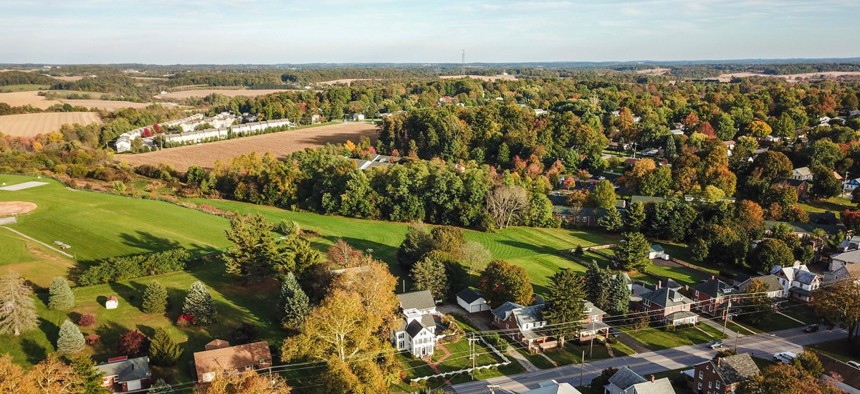Finding the Flaws in the Federal Broadband Maps

Frustrated with the FCC maps, the National Association of Counties and other federal agencies are looking to figure out which communities lack broadband access.
WASHINGTON — The National Association of Counties plans to launch a mobile app Monday that will help the organization crowdsource broadband speed maps to pinpoint the flaws in the Federal Communication Commission’s much-criticized maps.
The app was created in partnership with the Rural Community Assistance Partnership and Rural Local Initiatives Support Coalition and has users identify areas with low or no internet connectivity by testing speeds where they’re located.
That open data will then be aggregated and used to advocate for increased broadband infrastructure funding in underserved places.
“If you look at the federal data, it shows that almost every ZIP code in America has high-speed, affordable broadband,” Matt Chase, executive director of NACo, told Route Fifty. “We know that’s not true.”
If a single household within a census tract had the potential for broadband access then the entire tract was deemed covered, Chase said.
The FCC recently sent out a news release detailing a forthcoming report that the agency said would show increased availability of broadband access across the country. Specifically, the commission said the draft 2019 broadband deployment study will show the number of Americans lacking access to a fixed connection meeting the minimum speed requirement of 25 megabits per second dropped from 26.1 million in 2016 to 19.4 million in 2017, or more than 25 percent. Most of the people who gained access, 5.6 million, lived in rural America, according to the release.
“For the past two years, closing the digital divide has been the FCC’s top priority,” said FCC Chairman Ajit Pai, a Republican, in a statement. “We’ve been tackling this problem by removing barriers to infrastructure investment, promoting competition, and providing efficient, effective support for rural broadband expansion through our Connect America Fund.”
Commissioner Jessica Rosenworcel, a Democrat, contested the report’s findings that broadband deployment is currently “reasonable and timely” in a tweet, arguing millions of households in rural and urban communities still lack access to high-speed service.
Montgomery County, Maryland isn’t rural but lacks cell service and high-speed internet in certain parts, Chase said, and they’re not the only NACo members complaining their residents and businesses need more bandwidth and redundancy.
The FCC knows its maps are bad, Chase added.
“It’s industry-provided data, and what we’re seeing with small cell 5G is this particular FCC is very willing to preempt state and local governments,” he said. “We’re now having to give free access to public rights of way to a for-profit company. They’re actually putting the telecommunications industry above other utilities, where other utilities have to provide access to their infrastructure, their poles.”
A 2018 Microsoft study placed the number of people lacking access to broadband in rural America alone at 19 million.
Multiple federal agencies have begun work identifying underserved areas, including the National Telecommunications and Information Administration, which on Feb.13 announced its own broadband access map in partnership with eight states: California, Maine, Massachusetts, Minnesota, North Carolina, Tennessee, Utah, and West Virginia.
On Thursday, Agriculture Secretary Sonny Perdue called FCC coverage maps “fake news” and said the U.S. Department of Agriculture is polling individual states to find out where service is bad.
The federal stimulus provided hundreds of millions of dollars to develop broadband maps based off the Connect Kentucky model, but that effort involved nonprofits being created because the telecommunications industry didn’t want to give their maps to governments—opening them up to public records requests, Chase said.
“So they created an intermediary, and in Kentucky they used the water and sewer lines to determine if there was broadband access,” he said. “If there was a water and sewer line they said, ‘Well, there’s broadband.’ That doesn’t compute.”
But Jessica Denson, a spokeswoman for Connected Nation, which grew out of the Connect Kentucky project, said intermediaries also included for-profits. The group pooled infrastructure maps and resident surveys to determine access, she added, while also advocating for dig-once policies that would see fiber laid at the same time water and sewer work is performed.
“It should have been coordinated so everyone was doing their data the same way,” Denson said.
But the stimulus bill had no such requirements about how maps would be developed.
NACo’s app, called TestIT, won’t collect any names or personal data, Chase said, but simply upload and download speeds to start populating broadband maps.
The association’s Rural Action Caucus will meet with the FCC on Wednesday to discuss broadband and fifth-generation wireless issues in underserved areas.
“Nobody wants to deploy more advanced technologies than counties for our 911 systems, for business,” Chase said.
Editor's note: This story was updated to include comments from Connected Nation.
Dave Nyczepir is a News Editor at Route Fifty and is based in Washington, D.C.
NEXT STORY: USDA Invests $122 Million in Rural Electric Infrastructure






